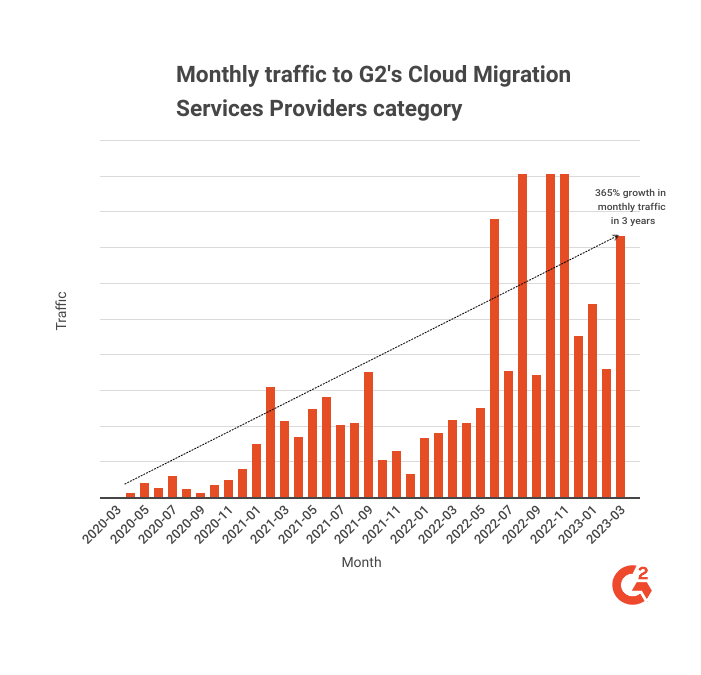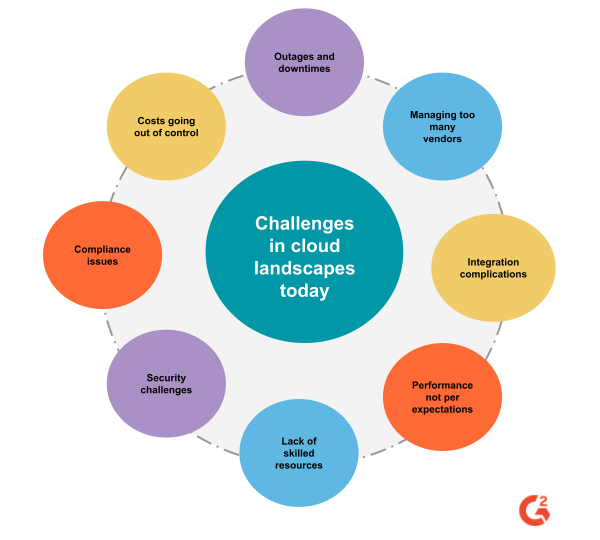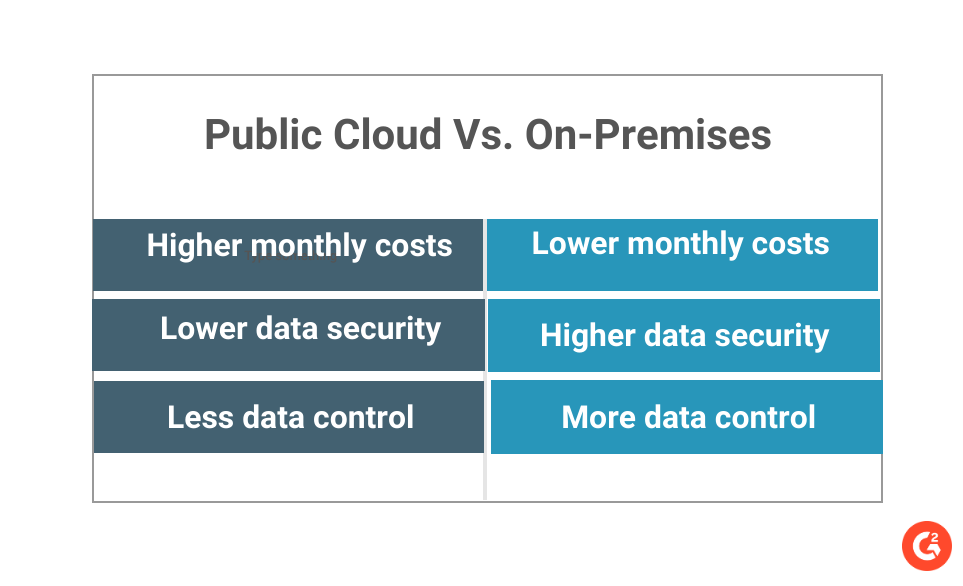Cloud has been the preferred option for all kinds of businesses over the past years. Everyone loves the cloud. Or at least they used to—until the challenges with the cloud started to outweigh the benefits.
We now see companies jumping off the cloud bandwagon and back to the ground. This might not be for everyone since the cloud still holds tremendous benefits if managed well. But we still see many companies contemplating the move to on-premises systems with the security and performance benefits it promises.
Reverse cloud migrations: Are enterprises moving off the cloud?
Companies have moved their workloads to the cloud with their digital transformation roadmap. The availability of cutting-edge technologies like AI and big data meant those not on the cloud feared lagging behind. The last few years especially have seen aggressive cloud migration and investments. There has been an incremental increase in traffic to G2’s Cloud Migration Services Providers category.

But the cloud, which was supposed to make life easier, is getting more difficult by the day. For some, it has not provided as much return on their investment as expected.
What exactly is making companies look back to on-premises?
Companies moved to the cloud seeking cost savings and because competitors were moving to the cloud. Many did so without deliberations on what value they wanted to derive from this investment. Now, they have started to realize that they aren't getting the expected value from their cloud investments, which is making them wonder if on-premises was better after all.

The ever-growing mountain of vendors, contracts, and bills
Cloud is as flexible as you want it or as simple as you need it to be. Multi-cloud environments where applications from different vendors work on infrastructure provided by yet another set of vendors lead companies to create cocktails of applications, platforms, and infrastructure. But along come mountains of contracts and billings.
A heterogeneous set of software that does not integrate, especially in mergers and acquisitions
Cloud solutions are supposed to integrate with other applications easily and seamlessly communicate with all systems. But that’s easier said than done. For instance, applications from different vendors might not work together, or solutions might have limitations that go unnoticed in the purchase process. The problem is even more acute when there is a merger or acquisition, with a lot of teething problems like access, data movement, and security.
Costs running out of control
It is easy to get lost in the labyrinth of many solutions and vendors and lose control of cloud costs. Without the right cost management strategies and tools, companies end up overspending their IT budgets. With business-critical operations on the cloud, companies cannot afford any downtime. So they have added redundancies, which in turn has increased costs.
Lack of skilled staff to manage cloud workloads
A cloud environment is a machine with many moving parts that cannot stop even for a few seconds. Different parts demand different specialists, along with generalists who need to have the know-how of end-to-end systems. The lack of skilled labor to manage the cloud landscape is a considerable challenge that companies face today. According to the U.S. Bureau of Labor Statistics, the demand for software developers, testers, and analysts is expected to grow 25% in the next 10 years, much faster than other average occupations.
Growing security concerns
Access control, compliance, and visibility of connections spread across the globe can be challenging. Eighty-one percent of organizations have suffered cloud security events in the last year, according to a survey by Venafi, a cyber security company. With integrations to so many applications, and information flowing between them, security is one of the biggest concerns of organizations, especially those dealing with highly critical and confidential data. More than 4100 publicly disclosed data breaches were reported in 2022, according to the Cyber Security Hub, pushing companies to seriously evaluate their cloud data strategies.
Adherence to compliance
Many industries like finance and healthcare are heavily regulated and need their data stored strictly on-premises. On-premises storage solutions help such industries comply with the laws and regulations such as HIPAA, GDPR, and PCI DSS to avoid heavy penalties.
Cloud outage
Last year witnessed a few major cloud outages. In June 2022, Microsoft Azure faced a severe cloud outage due to a sudden oscillation of power in one of the local data centers, and the air handling units shut down. The main challenge with outages of the cloud is to identify the exact cause behind it. Organizations have suffered significant losses due to such outages at various times. On-premises data storage solutions can help end users access data offline as well.
Performance issues
Data transfer rates in the cloud are highly variable and depend upon available bandwidth and the cloud provider’s workload. There can be a loss of time if the transfer speed is slow.
On-premises promises better security, performance, and compliance than the public cloud
Cloud has provided some incredible benefits of flexibility and agility that on-premises solutions previously could not. But now, on-premises solutions provide many of these capabilities in a safer way, albeit at higher costs. Companies have now realized that all their workloads need not necessarily be on the public cloud. Thus, large companies that can afford to are gravitating towards on-premises deployments.
According to a study by McKinsey, data management costs between 2019 and 2021 increased by 50% in the previous three years. Thus organizations now have to see if they have the proper infrastructure to make use of their data. With most cloud providers, the cost increases linearly with system usage. Companies these days look to become data-driven by optimizing their data management. At the same time, they want to perform on a budget.
A few years ago, cloud services were cost-effective and still are with small and mid-size businesses. However, as the organizations grow, so does the requirement for the resources to store and manage data. Yet, cloud consumption patterns remain constant, ultimately making the cloud’s pay-per-use model a costly affair.

What is an on-premises computing environment?
On-premises is an IT infrastructure terminology consisting of hardware and software applications hosted on site. Unlike cloud providers, organizations have control over their own data with on-premises deployment. On-premises computing environments are installed in the company's hardware infrastructure and hosted locally. A license is usually required to set up on-premises software.
On-premises solutions can use the same technology as the cloud but differ mainly in the consumption model. On-premises software comes with the operational expenditure (OPEX) model or consumption-based pricing, which means that the organizations pay for the services used. Many on-premises service providers nowadays provide consumption-based pricing.
How can on-premises storage benefit end-users and organizations?
- Deployment: As the resources are deployed in-house, within an organization’s IT infrastructure, the organizations have better control over the physical servers and storage solutions. This also gives an added advantage of customization of servers according to the organization’s needs.
- Security: Organizations have a lot of sensitive data that is usually stored on-premises. The organizations can limit access to only necessary team members, providing a great deal of security to the stored data. On-premises storages also help to keep the data offline as the storage does not require any network connection and thus keep the data away from cyberattacks.
- Control: On-premises deployments give organizations better control over their data. This is possible as the organization can decide on the access to be given. Thus on-premises storage has consolidated the management of data.
- Cost-effectiveness: On-premise solutions are cost-effective in the long run. They do not involve recurring costs like cloud services.
Challenges with moving from cloud to on-premises
While there are many advantages of getting the data in-house, companies might also have to face certain challenges in terms of various parameters:
- Infrastructure: One of the major challenges of reverse cloud migration is the right infrastructure where the data will be stored. Companies can use the existing infrastructure to reduce excessive cloud repatriation costs. At the same time, we recommend ensuring that existing infrastructure meets the requirements for the data.
- Expertise: The organizations may need additional staff or engineers to manage the data. Verifying that the newly hired staff has enough experience managing on-premises data is necessary.
- Security: Small and mid-level enterprises may face security challenges given the limited resources. To overcome this hurdle, the companies can implement security best practices like limiting data access, regular backup, and consistent security audits to address potential security threats.
Although the points mentioned above may make it seem like a daunting move, it is also worth mentioning that with careful planning and execution, companies can overcome these challenges.
Hybrid cloud could lead the way
Although there are organizations that have migrated from the cloud to on-premises, there are other organizations that still choose to go with the cloud. According to G2 stats, 51% of the IT spending of the companies will be cloud in 2025.
While we will see some large enterprises shifting back to on-premises, it is not yet feasible for smaller companies, with all the costs and efforts involved. In any case, jumping entirely off the cloud will not happen in the next few years, with all the investments that have gone into the cloud.
We predict that companies will adopt a hybrid cloud structure, at least in the foreseeable future, that is expected to offer the best of both public cloud and on-premises worlds. In the next article of this series, we explore the advantages of the hybrid cloud. We will also explore things companies should consider if they decide to move to on-premises.
 This article is co-written by Shalaka Joshi, G2 research analyst, data & design
This article is co-written by Shalaka Joshi, G2 research analyst, data & design
Edited by Jigmee Bhutia
Vous voulez en savoir plus sur Plateforme Cloud en tant que Service (PaaS) Logiciel ? Découvrez les produits Plateforme en tant que service (PaaS).

Rachana Hasyagar
Rachana is a Research Manager at G2 focusing on cloud. She has 13 years of experience in market research and software. Rachana is passionate about cloud, AI, ERP, consumer goods, retail and supply chain, and has published many reports and articles in these areas. She holds an MBA from Indian Institute of Management, Bangalore, India, and a Bachelor of Engineering degree in electronics and communications. In her free time, Rachana loves traveling and exploring new places.
